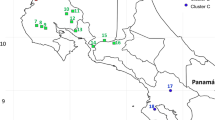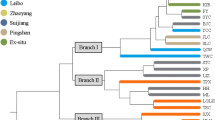Abstract
Baobab (Adansonia digitata L) belonging to Bombacaceae family, is one of the most widely used indigenous priority tree species in sub-Saharan Africa, valued in the cosmetic industry for its seed oil, and powdery fruit pulp for juice making. Baobab has high potential for domestication in southern Africa, therefore understanding its genetic diversity and population structuring is warranted. The study investigated the level of genetic diversity and differentiation of five populations of A. digitata L. sampled from four diverse silvicultural zones in Malawi. Variation at nine microsatellite loci were examined in 150 individual trees. Low mean genetic diversity was expressed through genetic diversity indices: Nei’s genetic diversity (h, 0.18 ± 0.03), Shannon Information Index (I, 0.21 ± 0.07), observed number of alleles (na, 1.47 ± 0.10), effective number of alleles (ne, 1.23 ± 0.04) and percentage polymorphic loci (pp, 48 %). The low genetic variation found is attributed to the population growing in marginal areas of genetic centre of diversity of the species, anthropogenic factors and founder effects. Moderate genetic differentiation was observed among populations (Gst = 0.13) indicating the presence of a large number of common alleles resulting in a homogenisation effect. Clustering of individual trees by genetic similarity coefficients indicated that mainland trees were genetically closer than the trees on Likoma Island. Mantel’s test showed a weak positive insignificant correlation (Z = 0.12; P = 0.64) between genetic distance among populations and actual distance on the ground implying that geneflow was not directly influenced by isolation by distance. The results suggest that seed distribution and tree improvement should recognise the presence of ecotypes and conservation measures should protect all the populations due to existence of private alleles which are of adaptive importance.




Similar content being viewed by others
References
Akinnifesi FK, Silesh G, Ajayi OC, Chirwa PW, Kwesiga FR, Harawa R (2008) Contribution of agroforestry research and development to livelihood of smallholder farmers in Southern Africa: 2 fruit, medicinal, fuelwood and fodder tree systems. Agric J 3(1):76–88
Amos W, Harwood J (1998) Factors affecting levels of genetic diversity in natural populations. Philos Trans Biol Sci 353(1366):177–186
Assogbadjo AE, Kyndt T, Sinsin B, Gheysen G, Van Damme P (2006) Patterns of genetic and morphometric diversity in baobab (Adansonia digitata) populations across different climatic zones of Benin (West Africa). Ann Bot 97:819–830
Assogbadjo AE, Kyndt T, Chadare FJ, Sinsin B, Gheysen G, Eyog-Matig O, Van Damme P (2009) Genetic fingerprinting using AFLP cannot distinguish traditionally classified baobab morphotypes. Agrofor Syst 75:157–165
Avila-Díaz I, Oyama K (2007) Conservation genetics of an endemic and endangered epiphytic Laelia speciosa (Orchidaceae). Am J Bot 94(2):184–193
Buiteveld J, Vendramin GG, Leonardi S, Kamer K, Geburek T (2007) Genetic diversity and differentiation in European beech (Fagus sylvatica L.) stands varying in management history. For Ecol Manag 247:98–106
Changadeya W (2009) Genetic morphological and socio-economic characterisation of Musa (Banana) cultivars growing in Malawi. Dissertation, University of Malawi, Limbe
Changadeya W, Kaunda E, Ambali AJD (2012) Molecular characterisation of Musa L. cultivars cultivated in Malawi using microsatellite markers. Afr J Biotechnol 11(18):4140–4157
Chirwa M, Chithila V, Kayambazinthu D, Dohse C (2006) Distribution and population structures of Adansonia digitata in Malawi. FRIM, Zomba
Dawson IK, Lengkeek A, Weber JC, Jamnaclass R (2009) Managing genetic variation in tropical trees: linking knowledge with action in agroforestry ecosystems for improved conservation and enhanced livelihoods. Biodivers Conserv 18:969–986
Edkins MT, Kruger LM, Harris K, Midgley JJ (2007) Baobabs and elephants in Kruger National Park: nowhere to hide. Afr J Ecol. doi:10.1111/j.1365-2028.2007.00798.x
Esselman EJ, Crawford DJ, Soren B, Stuessy TF, Anderson GJ, Silva MO (2000) RAPD marker diversity within and divergence among species of Dendroseris (Asteraceae: Lactuceae). Am J Bot 87(4):591–596
Gawal NG, Jarret RL (1991) Cytoplasmic genetic diversity in banana and plantain. Euphytica 52:19–23
Giang LH, Hong PN, Tuan MS, Harada K (2003) Genetic variation of Avicennia marina (Forsk) Vierh. (Avicenniaceae) in Vietnam revealed by microsatellite and AFLP markers. Genes Genet Syst 78:399–407
Glaubitz JF, Moran GF (2000) Genetic tools: the use of biochemical and molecular markers. In: Young A, Boshier D, Boyle T (eds) Forest conservation genetics. Principles and Practice. CSIRO Publishing, Wallingford
Guy GL (1971) The baobabs: Adansonia spp. (Bombacaceae). J Bot Soc S Afr 57:31–37
Hardcastle PD (1978) A preliminary silvicultural classification of Malawi. Forestry Research Institute of Malawi. Forestry Research Record No. 57
Heywood VH, Watson RT (1995) Global biodiversity assessment. Cambridge University Press, Cambridge
Kelly BA, Hardy OJ, Bouvet J (2004) Temporal and spatial genetic structure in Vitellaria paradoxa (shea tree) in an agroforestry system in southern Mali. Mol Ecol 13:1231–1240
Kimura M, Crow JK (1964) The number of alleles that can be maintained in a finite population. Genetics 49:725–738
Kyndt T, Assogbadjo AE, Hardy OJ, Kakaïa RG, Sinsin B, Van Damme P, Gheysen G (2009) Spatial genetic structuring of baobab (Adansonia digitata, Malvaceae) in the traditional agroforestry systems of West Africa. Am J Bot 96(5):950–957
Larsen AS, Vaillant A, Verhaegen D, Kjaer ED (2009) Eighteen SSR-primers for tetraploid Adansonia digitata and its relatives. Conserv Genet Resour. doi:10.1007/s12686-009-9075-y
Lewontin RC (1974) The genetic basis of evolutionary change. Columbia University Press, New York
Maghuly F, Pinsker W, Praznik W, Fluch S (2006) Genetic diversity in managed subpopulations of Norway spruce [Picea abies (L) Karst]. For Ecol Manag 222:266–271
Mwase WF, Bjornstad A, Stedje B, Bokosi JM, Kwapata MB (2006) Genetic diversity of Uapaka kirkiana Muel. Arg. Populations as revealed by amplified fragment length polymorphism (AFLPs). Afr J Biotechnol 5(13):1205–1213
Nassar JM, Hamrick JL, Fleming TH (2003) Population genetic structure of Venezuelan chiropterophilous columnar cacti (Cactaceae). Am J Bot 90(11):1628–1637
Nei M (1972) Genetic distance between populations. Am Nat 106:283–292
Nei M (1973) Analysis of gene diversity in subdivided populations. Proc Natl Acad Sci USA 70:3321–3323
Nei M (1978) Estimates of a verage heterozygosity and genetic distance from a small number of individuals. Genetics 89:583–590
Pluess AR, Stöcklin J (2004) Population genetic diversity of the clonal plant Geum reptans (Rosaceae) in the Swiss Alps. Am J Bot 91(12):2013–2021
Pocktsy JL, Lumaret R, Mayne D, Mohamed VA, Abutaba YIM, Sagna M, Raoseta S, Danthu P (2009) Chloroplast DNA phylogeography suggest a West African centre of origin for the baobab, Adansonia digitata L (Bombacoideae, Malvaceae). Mol Ecol 18:1707–1715
Promega (2000) Life science catalog. www.promega.com
Rholf JR (2001) NTSYpc Version 2.11c numerical taxonomy and multivariate analysis system, Exeter Software, New York
Sidibe M, Williams JT (2002) Baobab. Adansonia digitata. International Centre for Underutilised Crops, Southampton
Sneath PHA, Sokal RR (1973) Numerical taxonomy. Freeman, San Francisco
Sreekumar VB, Renuka C (2006) Assessment of genetic diversity in Calamus thwaitesii BECC. (Arecaceae) using RAPD markers. Biochem Syst Ecol 34:397–405
Wickens GE (1982) The baobab: Africa’s upside-down tree. Kew Bull 37(2):173–209
Wilson RT (1988) Vital statistics of the baobab (Adansonia digitata). Afr J Ecol 26:197–206
Yeh FC (2000) Population genetics. In: Young A, Boshier D, Boyle T (eds) Forest conservation genetics. Principles and Practice. CSIRO Publishing, Wallingford
Yeh FC, Yang RC, Boyle T (1999) POPGENE Version 1.31, Microsoft window-based freeware for population genetics analysis. Quick User Guide, University of Alberta and Centre for International Forest Reserch, Alberta, Canada
Zobel B, Talbert J (1984) Applied forest tree improvement. Wiley, New York
Acknowledgments
The study was co-financed by Mzuzu University and Stellenbosch University. Special thanks go to Mr. Y. Kazembe and Miss E Aquaron of Molecular Biology and Ecology Research Unit (MBERU), Department of Biological Sciences, Chancellor College, University of Malawi for helping during the extraction of DNA. Mr. S. Kamowa of Mzuzu University is thanked for active participation in field work. Lastly, we thank Pretoria University for hosting the first author at the time of writing the article.
Author information
Authors and Affiliations
Corresponding author
Rights and permissions
About this article
Cite this article
Munthali, C.R.Y., Chirwa, P.W., Changadeya, W.J. et al. Genetic differentiation and diversity of Adansonia digitata L (baobab) in Malawi using microsatellite markers. Agroforest Syst 87, 117–130 (2013). https://doi.org/10.1007/s10457-012-9528-2
Received:
Accepted:
Published:
Issue Date:
DOI: https://doi.org/10.1007/s10457-012-9528-2




